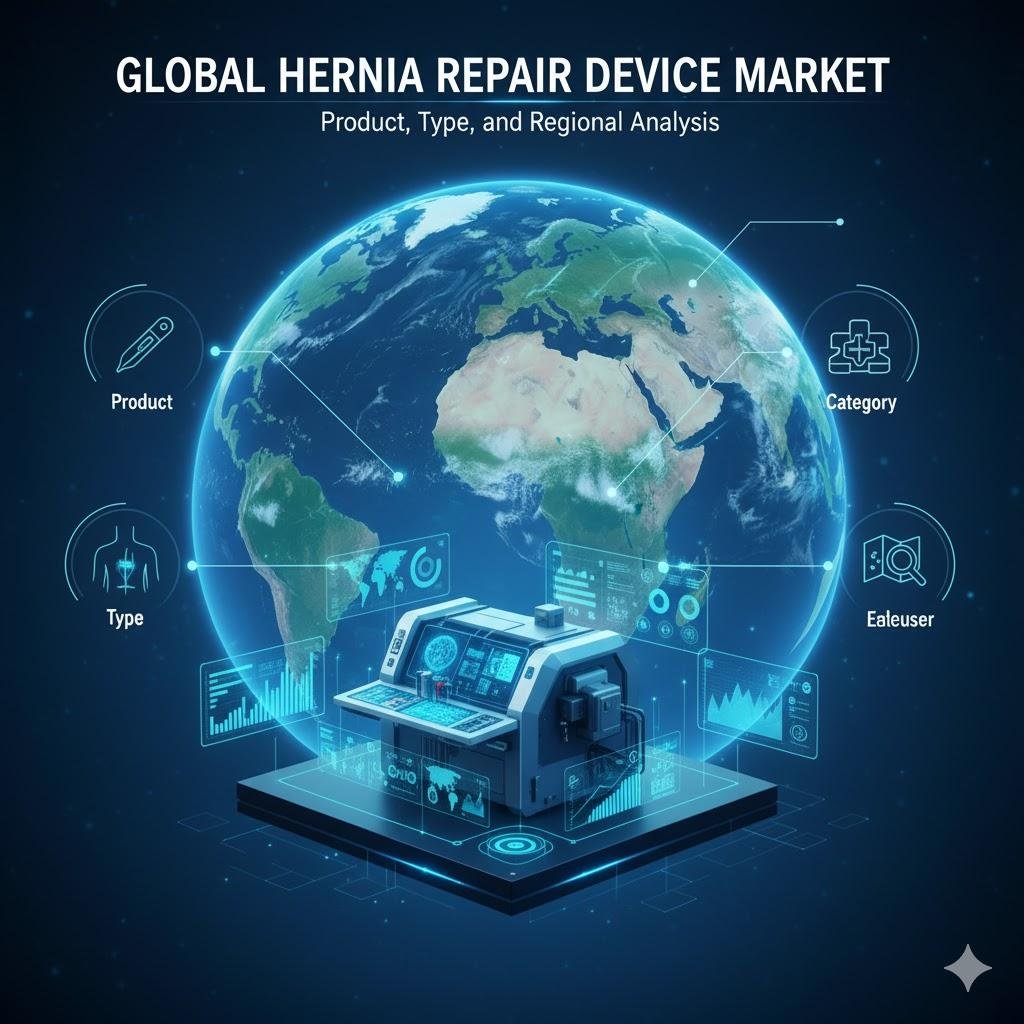Global Hernia Repair Device Market: Product, Type, and Regional Analysis (2024–2032)

The Global Hernia Repair Device Market is a mature yet steadily growing segment within the medical device industry, driven by the high prevalence of hernias, advancements in surgical techniques, and an increasing preference for minimally invasive procedures. A hernia occurs when an organ or fatty tissue squeezes through a weak spot in a surrounding muscle or connective tissue. The repair of hernias predominantly involves the use of surgical meshes and fixation devices to reinforce the weakened area.
According to Credence Research Global Hernia Repair Device Market size was valued at USD 3,991.3 million in 2018 to USD 5,279.3 million in 2024 and is anticipated to reach USD 8,131.1 million by 2032, at a CAGR of 5.61% during the forecast period.
Source: https://www.credenceresearch.com/report/hernia-repair-devices-market
1. Market Segmentation: Detailed Analysis
1.1. By Product
This segment is the core of the market, divided into two main categories: Meshes and Fixation Devices.
- Meshes (Surgical Meshes):
- Dominant Share Holder: This segment accounts for the largest portion (70-75%) of the market revenue. Meshes are the standard of care in most hernia repairs, providing a scaffold for tissue ingrowth and strengthening the repair.
- Sub-segmentation by Material:
- Biological Meshes: Derived from human or animal tissue (e.g., porcine, bovine). They are biodegradable and integrate with the patient's tissue.
- Drivers: Used in contaminated or high-risk surgical fields due to their lower risk of infection and adhesion formation. Growth is driven by complex hernia cases.
- Synthetic Meshes: Made from polymers like polypropylene, polyester, or ePTFE. They are the most widely used type.
- Drivers: Cost-effectiveness, proven long-term efficacy, and wide availability. Further categorized into:
- Absorbable: Provide temporary support and are fully absorbed by the body.
- Non-Absorbable: Provide permanent reinforcement.
- Composite/Hybrid: Combine layers of different materials (e.g., a synthetic layer for strength and an absorbable barrier to prevent adhesions to organs).
- Fixation Devices:
- Essential Supporting Segment: These devices are used to secure the mesh in place. This segment is growing in tandem with the adoption of minimally invasive surgery.
- Sub-segmentation by Type:
- Tackers/Staplers: Mechanical devices used in laparoscopic surgery to fix the mesh to the abdominal wall. This is the largest sub-segment.
- Sutures: Traditional and widely used for mesh fixation in open surgery.
- Fibrin Sealants/Glues: Biological adhesives that provide atraumatic fixation, reducing post-operative chronic pain.
- Drivers: Growing evidence supporting the use of glue to reduce post-operative pain and nerve entrapment compared to mechanical tackers.
1.2. By Type (Hernia Type)
This segmentation reflects the clinical application of the devices based on the anatomical location of the hernia.
- Inguinal Hernia:
- Largest and Most Common Segment: Accounts for over 70% of all hernias. It occurs in the groin area and is far more common in men.
- Drivers: High prevalence, aging male population, and the standardization of tension-free mesh repair as the gold-standard treatment.
- Incisional/Ventral Hernia:
- Significant and Growing Segment: Occurs at the site of a previous surgical incision.
- Drivers: Rising volume of abdominal surgeries globally, growing obesity rates (a major risk factor), and increasing adoption of advanced biological meshes for complex reconstructions.
- Umbilical Hernia:
- Common in infants but also occurs in adults. Repairs often use synthetic meshes, especially for larger defects.
- Femoral Hernia:
- Less common, occurring just below the inguinal ligament, more frequent in women. Repair techniques are similar to inguinal hernia.
- Hiatal Hernia:
- Involves the stomach pushing into the chest cavity. Repair often involves mesh for large defects, though the market is smaller compared to abdominal wall hernias.
- Other Hernias: Include rare types like Spigelian or obturator hernias.
2. Regional Analysis (2024–2032)
- North America:
- Market Leader: Holds the largest market share, driven by high healthcare expenditure, advanced healthcare infrastructure, and high awareness.
- Key Drivers: High prevalence of obesity and hernia, rapid adoption of advanced biological meshes and minimally invasive techniques, and the presence of major market players (e.g., BD, Medtronic, Johnson & Johnson).
- Europe:
- Mature and Significant Market: The second-largest market, with strong growth in Western Europe.
- Key Drivers: Well-established healthcare systems, favorable reimbursement policies, and a growing aging population. Stringent regulatory standards (MDR) influence product innovation and approval.
- Asia-Pacific (APAC):
- Fastest-Growing Region: Expected to witness the highest CAGR during the forecast period.
- Key Drivers: Large and growing population, increasing healthcare access, rising medical tourism (especially in India and Thailand), growing adoption of modern surgical techniques, and increasing healthcare expenditure. Rising awareness among both patients and surgeons is a key catalyst.
- Latin America:
- Emerging Market: Shows steady growth potential, led by Brazil and Mexico.
- Drivers: Improving healthcare infrastructure and increasing investment from global players. Economic volatility can be a restraining factor.
- Middle East & Africa (MEA):
- Nascent but Promising Market: Growth is concentrated in the Gulf Cooperation Council (GCC) countries due to high healthcare spending.
- Drivers: Government initiatives to modernize healthcare and a growing medical tourism sector. The rest of the region faces challenges due to limited access to advanced care.
3. Key Market Drivers and Trends
- Primary Drivers:
- Rising Prevalence of Hernias: Linked to an aging population, obesity epidemic, and increasing number of abdominal surgeries (leading to incisional hernias).
- Shift to Minimally Invasive Surgery: Laparoscopic and robotic-assisted hernia repairs offer benefits like less pain, shorter hospital stays, and quicker recovery, driving demand for compatible meshes and fixation devices like tackers.
- Technological Advancements: Development of lightweight, large-pore synthetic meshes; resorbable synthetic meshes; and advanced biological matrices.
- Growing Patient Awareness: Increased health literacy and access to information are leading more patients to seek treatment.
- Key Trends:
- Robotic-Assisted Hernia Repair: Gaining significant traction, offering enhanced precision for surgeons, which is driving the development of specialized meshes and instruments.
- Personalized Medicine: Tailoring the choice of mesh (biological vs. synthetic, lightweight vs. standard) to the individual patient's risk profile (e.g., risk of infection, contamination).
- Focus on Reducing Chronic Pain: Development and promotion of atraumatic fixation devices like fibrin glue and absorbable tackers to address post-herniorrhaphy pain, a key concern.
- Consolidation and M&A: Larger medical device companies are acquiring smaller, innovative firms to broaden their product portfolios in the hernia repair space.
4. Challenges and Restraints
- Product Recalls and Litigation: Historical issues with certain mesh products have led to lawsuits and heightened regulatory scrutiny, impacting market confidence.
- Stringent Regulatory Approval Processes: The classification of meshes as high-risk devices in many regions (like under EU MDR) requires extensive clinical data, slowing down new product launches.
- High Cost of Advanced Meshes: Biological meshes and robotic procedures are expensive, limiting their adoption in cost-sensitive markets and healthcare systems.
- Post-Operative Complications: Concerns about mesh-related complications such as infection, adhesion, erosion, and chronic pain remain a challenge for the industry.
5. Competitive Landscape
The market is highly competitive and consolidated, featuring:
- Global Medical Device Giants: Medtronic, Johnson & Johnson (Ethicon), and BD (Becton, Dickinson and Company) are the dominant players with comprehensive portfolios of meshes and fixation devices.
- Leading Specialized Players: W. L. Gore & Associates, Getinge (Maquet), and B. Braun hold significant market shares with their innovative mesh technologies.
- Emerging Players: Several smaller companies focus on niche segments, such as specific biological meshes or novel fixation systems.
- Competitive Strategies: Include continuous R&D for next-generation products, strategic M&A, strong surgeon training and education programs, and geographic expansion into high-growth APAC markets.
In conclusion, the Global Hernia Repair Device Market is on a stable growth path, fueled by demographic trends and technological innovation. The future of the market lies in the development of smarter, more biocompatible materials, the refinement of minimally invasive and robotic techniques, and a greater focus on improving long-term patient outcomes, particularly in reducing chronic pain and recurrence rates
Source: https://www.credenceresearch.com/report/hernia-repair-devices-market





